








Midweek Update 26 October 2023Google Banner Ad THIS WEEK IN MIDWEEK UPDATE SAAF Gripen engine support contract finally awarded. Incomar grows its fleet as its business expands. The dizzying possibilities of drones in Africa. Daher marks an aviation milestone with its delivery of the 500thTBM 900-series highly efficient turboprop-powered aircraft. Cirrus Aircraft celebrates 500 Vision Jet deliveries with limited edition series. Lilium Jet becomes first eVTOL for private sale in the US in pioneering partnership with EMCJET. Vivajets Unveils Fractional Aircraft Ownership Service, Commits to Business Connectivity in Africa. This week in History - French pilot Lt Roland Garros is shot down and killed in combat. Bonus Video - Yak 55 Russian Aerobatic Monster. 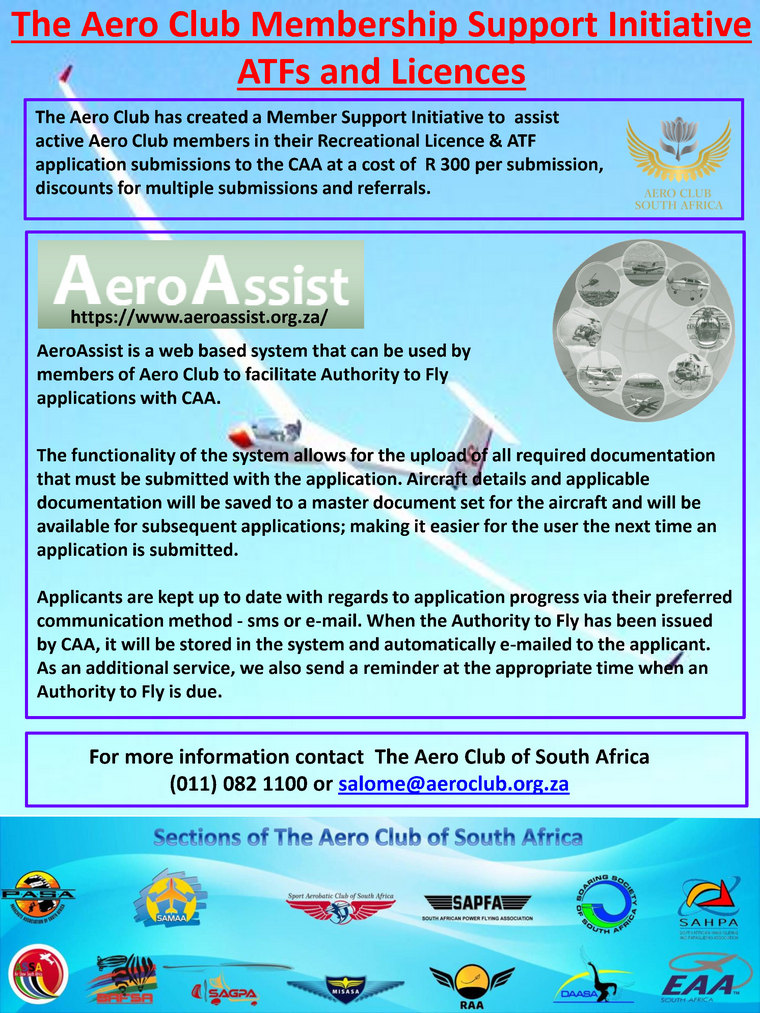   24 October to 4 November. SAC Advanced World Aerobatics Championships Las Vegas. Contact Annie Boon E-mail: info@anniesaviationcorner.com 28 SAPFA SA Landing Championships - Brits & Stellenbosch airfields. Contact Ron Stirk E-mail: melron@mweb.co.za Cell: 082 804 445 0373 28 EAA Fly in to Brits.  4 EAA Chapter 322 breakfast fly-in gathering, boot sale, fly market EAA Auditorium. Contact Neil Bowden E-mail: airadventuresa@gmail.com 4 Brakpan Aero Club Cessna fly-in. Contact Clarissa E-mail: Clarissa@airborneaviation.co.za Cell: 074 113 2911 4 Gyro Fly-In Kitty Hawk Airfield. All aircraft welcome. RSVP Juanita 082 040 9798 11 EAA Chapter 322 breakfast fly-in venue TBA. Contact Neil Bowden E-mail: airadventuresa@gmail.com 13 to 17 Dubai Airshow 2023. Contact: henrietta.fernandes@dubai.aero 18 EAA National & Chapter 322 Annual Awards Dinner Venue TBA. Contact Neil Bowden E-mail: airadventuresa@gmail.com 25 Aero Club Awards 50 Viking Way Rand Airport (Menno Parsons hangar). Contact Sandra Strydom sandra@aeroclub.org.za Tel: 011 082 1100 26 SAA Museum Rand Airport in Memoriam SA 295 Helderberg. For more information call 076 879 5044 or email info@saamuseum.co.ca    SAAF IN CRISIS AS AIRCRAFT SERVICEABILITY DROPS TO LESS THAN 20% Kim Helfrich/Guy Martin www.defenceweb.co.za As Marais notes in his response on 18 October, "most concerning" is that "a staggering 85% of the SAAF's aircraft fleet is currently out of action, leaving the nation vulnerable to security threats." The majority of the SAAF fleet is grounded due to "a lack of spares or budget constraints to conduct the necessary repairs". Modise's reply also informs him unavailability of aircraft implies SAAF defence readiness is "compromised" with aircrew having to regain currency and "the lack of aircraft availability poses a challenge". She goes further stating: "The challenge is the severe unavailability of funds to place contracts and it's not as a result of non-performance by Armscor or SAAF. Armscor had to engage with contractors within limited available funds and, in numerous instances, has not yielded positive results". An Armscor presentation to Parliament's Portfolio Committee on Defence and Military Veterans last month revealed there are maintenance and repair contracts in place for most SAAF types, but almost all of these are only partially funded.  That South Africa's air defence capability, vested in Lieutenant General Wiseman Mbambo's SAAF, cannot put more than half its aircraft into the air leaves the country "exposed and vulnerable". As examples, Modise's response has it that of the SAAF's 11 Rooivalk combat support helicopters, three are serviceable with the remaining eight in need of "major repairs/rebuilds" with an ROM (rough order of magnitude) for spares to make six airworthy R1 billion. One of four Super Lynx maritime helicopters is serviceable with "three awaiting various spare parts by June 2024". (The most updated information defenceWeb has is that two are serviceable.) There are five SAAF rotary-wing workhorse Oryx serviceable with two "beyond economic repair", 10 needing major rebuilds, two more on the major rebuild list following accident damage and 22 "grounded at squadrons awaiting critical parts". An estimated R2.5 billion is needed to make the 39-strong Oryx fleet airworthy. Other types in service are in much the same situation with, in one instance, the venerable C-47TP used by Air Force Base (AFB) Ysterplaat-based 35 Squadron for maritime patrol and reconnaissance work at high risk of not flying again. This because no maintenance or repair contract can be placed as there is "no OEM (original equipment manufacturer) for this platform in industry". The primary SAAF training aircraft - Pilatus PC-7 Mk II - based at AFB Langebaanweg, is another type to suffer - with aspirant pilots not doing the training hours they should. Six of a fleet of 35 are serviceable with Modise's response noting "specification for a new contract with Pilatus AG was not acceptable". It appears the door has not completely closed as "negotiations are ongoing to resolve the impasse". R1 billion has been made available from National Treasury to get the C-130BZ fleet airworthy, but there are no maintenance contracts in place for the C-47TP, Cessna Caravan or King Air, although Armscor is in the process of appointing a King Air maintenance contractor. Defence expert Dean Wingrin pointed out that no air force has a 100% serviceability rate, but around 15% for the SAAF "is shocking." The major cause, he said, is an insufficient defence budget, ineffectual and inefficient procurement process and a lack of political will and support. "I suppose the lack of understanding by Treasury of the unique defence environment does not help either," he added. While South Africa's poor economy is largely to blame, "the Government has been warned about this for a long time. It comes as no surprise. The effects of a reduced (aviation) capability have been felt throughout the SANDF and it has already led to fatal consequences," he said. "Talk of an updated defence policy/review/White Paper is too late. The Government needs to do better." Darren Olivier, Director at African Defence Review, pointed out that it's important to note Modise's statistics are a point in time measurement that does change from day to day, "so what we really need are average rates across each quarter and year. For instance, two Super Lynxes are serviceable now, not just one. Even so, these are bad numbers." 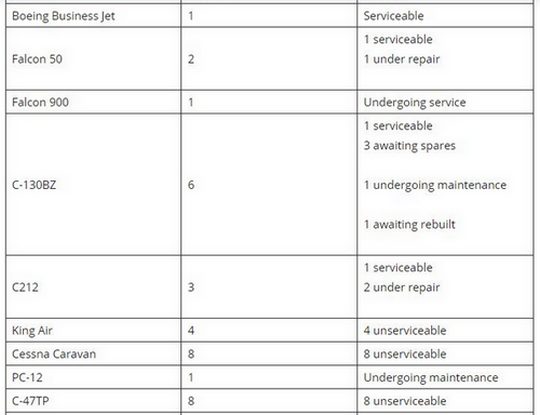 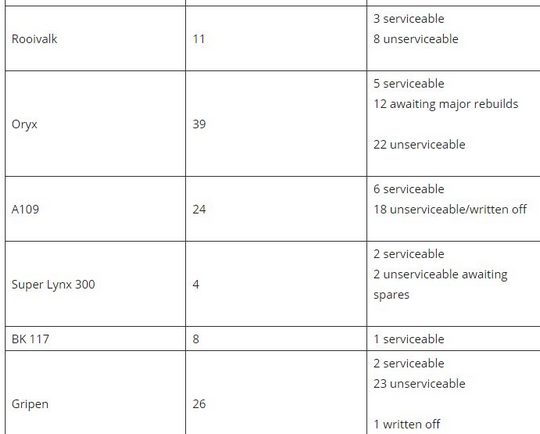 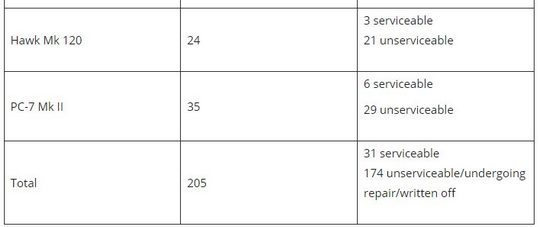   SAAF GRIPEN ENGINE SUPPORT CONTRACT FINALLY AWARDED Guy Martin www.defenceweb.co.za According to an Armscor presentation delivered to Parliament's Portfolio Committee on Defence and Military Veterans (PCDMV) in mid-September, Saab as the original equipment manufacturer (OEM) has an airframe support contract for the Gripen in place from September 2022 to end August 2025, worth R650 million (of which R476 million is funded). 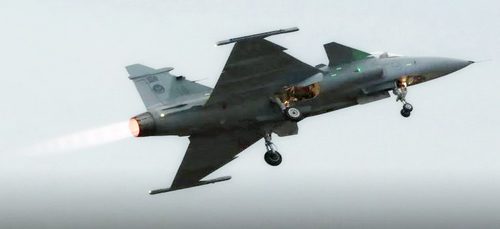 South Africa has been operating the Gripen C/D since 2008 and is Saab's first export customer for the type. The South African Air Force was forced to ground the Gripen in September 2021 due to budget constraints that saw a delay in finalising a new maintenance support contract with Saab and GKN as the original airframe and engine manufacturers respectively. With the maintenance contract being finalised, a Gripen took to the air again on 5 September 2022. Members from 2 Squadron at Air Force Base Makhado as well as Saab representatives assisted in getting the aircraft airworthy ahead of the Africa Aerospace and Defence (AAD) 2022. Gripens were more recently displayed prominently in August for the BRICS Summit in Johannesburg, where they performed combat air patrols along with Hawk Mk 120s. Due to the SAAF's tight budget, the support contract with Saab covers 13 aircraft over three years - the SAAF had 26 Gripen C/Ds, but one was written off following a ground incident. The remaining 12 will remain in storage. It is not clear how many engines the GKN contract covers. The other jet combat aircraft in SAAF service, the Hawk Mk 120 lead-in fighter-trainer, also has maintenance contracts in place. OEM BAE Systems was awarded the airframe maintenance contract, valid from September 2021 to end August 2024. This is worth R250 million, of which R221 million is funded. Armscor said the order is progressing well, with 90% of the material supply already delivered. "The product support contract (PSC) strategy has proven to be effective for the Hawk maintenance and support." Rolls Royce, as the engine OEM, was contracted to provide support from June 2022 to end May 2025 for the Hawk's Adour Mk 951 engine. This is valued at R29 million, with R19 million funded. "The order is progressing well," Armscor reported. Paramount Advanced Technologies is responsible for Hawk avionics maintenance from August 2023 to end July 2026. This contract is worth R9.6 million, with over half (R4.6 million) funded. Line replacement units that require repair are already at Paramount.  INCOMAR GROWS ITS FLEET AS ITS BUSINESS EXPANDS Guy Martin www.defenceweb.co.za 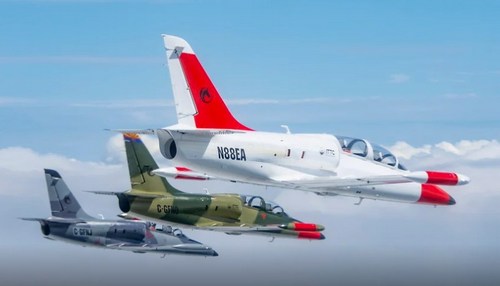 Incomar CEO Lance Wellington revealed that the company has acquired an Aermacchi AM.3C Bosbok which it aims to use as a light weapons development support platform. A Learjet 35 business jet has been acquired for high-speed testing and will arrive by year-end - it will support missile testing. The company's jet fleet will be further expanded with the acquisition of L-39 Albatros jet trainers. Wellington, speaking at the recent Aerospace Simulation and Training Symposium in Pretoria, explained that Incomar was established in 1999 with a focus on flight testing and avionics integration. It offers full flight physics and aeronautical engineering capabilities, including stores clearance and integration, ground vibration testing, aero modelling and simulation etc. Mechanical, hardware and electronic engineering covers structural design and analysis, development of avionics enclosures, thermal management and analysis, printed circuit board development, and firmware development. On the software side, Incomar can do software engineering and regarding avionics can develop mission computers, flight computers, stores management systems and ground control systems. The company can test and integrate benches and consoles. It has been building mission computers, flight computers, stores management systems, and ground control systems for a number of foreign clients. "We can take a project from full design to analytics, measuring and confirming the design," Wellington said, emphasising Incomar's strong aero modelling and simulation capabilities. For flight testing, Incomar employs Class I and II experimental test pilots and flight test engineers who can perform basic and full experimental testing of aircraft and systems - for example, Incomar pilots were the first to fly Paramount's Ahrlac/Mwari, and its pilots have amongst others tested a Hensoldt sensor pod on the company's Caravan. Incomar is part of the privately owned Arya Group. It was grown and developed together with Mongezi India, who has worked extensively in the aerospace, defence and civil security sectors (he served as Chief of Aviation Security for South Africa, for example). Incomar has grown rapidly in recent years, and now employs more than 240 people.   Africa Defence Forum www.defenceweb.co.za The Orion drones, manufactured by the French-American company Elistair, operate at the end of a 100 metre Kevlar cord. The tether provides power for up to 50 hours of flight time and secure, unjammable communication with operators. The drones are part of Nigeria's fleet of unmanned vehicles that makes it one of the continent's major players in drone technology. The terrorists that Nigerian authorities are looking for likely are watching them with drones of their own. According to analysts, terrorist groups such as Boko Haram and its offshoot, the Islamic State West Africa Province (ISWAP), use them for intelligence-gathering while also experimenting with turning inexpensive, commercially available drones into flying improvised explosive devices (IEDs) that they can use to launch attacks on civilian and military targets. 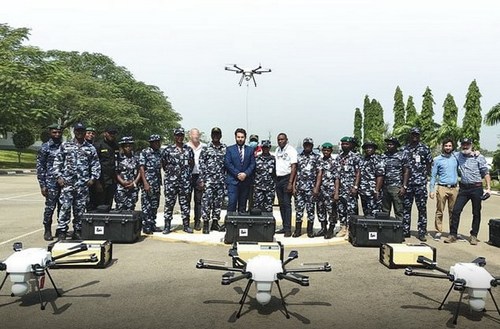 The growth of military-grade drone technology runs parallel to the accelerating availability of civilian-grade commercial drones, many of them made and marketed by China, that have the potential to be weaponized by extremist groups. "It's an unsophisticated technology that gains sophistication quickly," Adam Rosman, managing director of South African drone manufacturer Aerial Monitoring Solutions, told ADF. "There is a lot of possibility in Africa." The first drones deployed in Africa took to the skies in 1978, launched by South Africa to monitor the civil war in what was then Rhodesia. South Africa produced the continent's first homegrown drones, also known as unmanned aerial vehicles (UAVs), in the late 1980s. The use of modern drones began in 2001 when Botswana ordered a number of Israeli-made Silver Arrow Micro-V UAVs. Since then, drones increasingly have become must-have technology for governments across the continent. Nearly every country on the continent uses drones in some form. In most cases, those uses are peaceful - from delivering health care supplies to remote communities to monitoring wildlife preserves under threat from poachers. The COVID-19 pandemic cast a spotlight on Africa's nascent drone capacity as countries used aerial and ground-based drones to deliver vital public health information and to monitor lockdowns. "The African continent is becoming a key site for the adaptation of drones to many military and nonmilitary purposes," Nichola Heras, senior director for strategy and innovation at the New Lines Institute for Strategy and Policy, told ADF. In Sub-Saharan Africa, South Africa has become another major actor in the drone industry. South Africa manufactures drones for sale to other countries and has considered deploying them along its 5 244-kilometre border. Nigeria also makes its own drones. Cameroon acquired small military drones in 2018. Kenya has deployed drones to monitor al-Shabaab insurgents in neighbouring Somalia. The Democratic Republic of the Congo and Mozambique also have deployed drones in combat. Botswana, Côte d'Ivoire, Sudan and Zambia have added mid-sized tactical drones to their military fleet. The success of Turkish Bayraktar TB2 drones in Libya's civil war raised the profile of the weaponized drones, and militaries in Ethiopia, Morocco, Rwanda, Togo and Tunisia have acquired them. Angola is considering adding them as well. "The use of UAS [unmanned aerial systems] represents a new iteration of digital technology," analyst Karen Allen wrote for the Africa Center for Strategic Studies. The low cost of drone technology relative to a full-scale naval ship or air force jet means that cash-strapped militaries can add capabilities on a shoestring. Drones with infrared technology can see in the dark, a useful tool for observing poachers who often operate under the cover of night. They also can hover over a target or even follow one for an extended period. Their small profile makes them hard to spot and harder to shoot down. The presence of drones above a fishing vessel, along a border or above a wildlife park also can sow doubts in the minds of would-be bad actors - doubts that can make them halt illegal operations, according to Rosman. In their rush to buy drones, African nations soon could find themselves becoming the testing ground for the next step in drone technology: artificial intelligence. "Africa is an emerging market for this trend," Heras told ADF. "When paired with potential military capabilities, it could be a key site for prototyping autonomous drones in military contexts." The Libyan civil war might have already provided a glimpse of that future. With nearly 1 000 drone-based air strikes, Libya became a showcase for using them in combat. UN Special Representative to Libya Ghassan Salame called the conflict "the largest drone war in the world." From that battlefield emerged a United Nations report suggesting that an AI-equipped Turkish Kargu-2 drone may have, in the report's words, "hunted down and remotely engaged" enemy fighters without orders from human operators. The Kargu-2's developer describes the quadcopter drone as designed for loitering above a target with fully autonomous navigation and precision-strike capabilities. The strike action requires a human handler to be involved, according to the Kargu-2's website. It's unclear, however, whether that is how the attack actually happened, according to the UN report. "Once in retreat, they were subject to continual harassment from the unmanned combat aerial vehicles and lethal autonomous weapons systems," the report's authors wrote. Zachary Kallenborn, a part-time fellow at the Center for Strategic and International Studies' Strategic Technology Program who studies drones, told The New York Times that the report suggested that for the first time an AI-capable weapons system independently found and attacked people. Kallenborn told ADF all the components needed to create such a drone already exist.   DAHER MARKS AN AVIATION MILESTONE WITH ITS DELIVERY OF THE 500TH TBM 900-SERIES HIGHLY EFFICIENT TURBOPROP-POWERED AIRCRAFT. Daher today announced its delivery of the 500th TBM 900-series aircraft, underscoring the continued global market demand for this best-selling family in the highly efficient and fast TBM turboprop-powered product line. This accomplishment was detailed during Daher's press conference at the NBAA Business Aviation Convention & Exhibition (NBAA-BACE) in Las Vegas, Nevada. The milestone aircraft was a high-end TBM 960 version delivered to a private owner in the United States. "The latest TBM program achievement underscores the success of Daher's constant enhancement policy in maintaining the competitiveness of our aircraft portfolio, with an emphasis on listening to the customer and a commitment to enhancing operational efficiency and sustainability" Nicolas Chabbert, Senior Vice President of Daher's Aircraft Division. With more than 100 TBM 960s on order - exceeding two years of production - Daher sees a sustained interest in the aircraft from professional operators and private owners, especially with the introduction of enhanced safety features, along with improved efficiency and upgraded cabin comfort, Chabbert added. The 500 deliveries to date for TBM 900-series aircraft surpass the totals of both previous-generation TBM airplane types: 324 aircraft were produced in the TBM 700 configuration, while 338 TBM 850s were manufactured. The TBM 850 was the initial version that rolled out under Daher management of the TBM product line. Daher's introduction of the first TBM 900-series aircraft was in 2014 with the TBM 900 configuration, featuring such aerodynamic improvements as new engine cowlings, the addition of winglets and the integration of Hartzell's five-blade scimitar propeller. Daher's latest high-end TBM version is the TBM 960, unveiled by the company in 2022, and integrating the new PT6E-66XT turboprop engine - purpose-built by Pratt & Whitney Canada for this aircraft, as well as Hartzell Propeller's five-blade composite propeller with the Raptor™ lightweight hub. Both the engine and propeller system are linked to the TBM 960's dual-channel digital Engine and Propeller Electronic Control System (EPECS). The EPECS optimizes powerplant performance from the engine's startup to landing, while reducing pilot workload by integrating all functions and protecting the engine's life. It also enables the aircraft to be flown with more precise settings: at Daher's recommended cruise setting of 308 kts., the fuel consumption is only 57 U.S. gallons per hour - a 10 percent fuel economy for more sustainability when compared to the maximum cruise setting. Daher's use of digital power for the TBM 960 extends into the aircraft's Prestige cabin, featuring an all-new environmental control system. Other enhancements include LED ambience strip lighting integrated into both sides of the overhead ceiling panel, and electronically-dimmable windows - all controlled by a Passenger Comfort Display (PCD). Other enhancements for the cabin's style and comfort are the ergonomically enhanced seats, USB-A and USB-C power plugs, along with individual cupholders and headset hangers for each occupant. The TBM 960 benefits from a full range of TBM e-copilot® functions: icing protection system; flight envelope monitoring through the Electronic Stability and Protection (ESP) and the Under-speed Protection (USP) systems; the Emergency Descent Mode (EDM) function; as well as the game-changing HomeSafe™ emergency autoland system. During this week's NBAA Business Aviation Convention & Exhibition, Daher is showing a Model Year 2023 TBM 960 on the company's exhibit stand in the Las Vegas Convention Centre. This airplane features Garmin G3000® integrated flight deck enhanced with updated software and a control yoke activation button for the Garmin Electronic Checklists, along with a repositioning of the altimeter setting button as part of Daher's TBM ergonomic improvements. 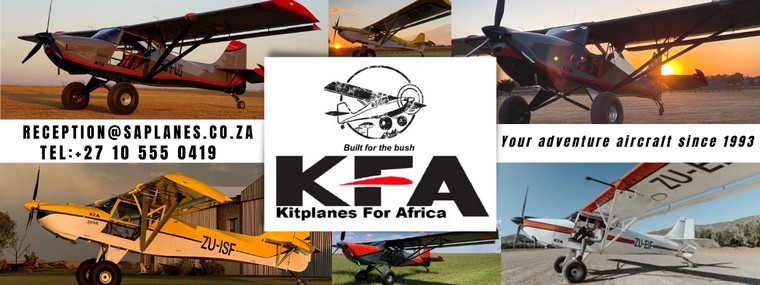 CIRRUS AIRCRAFT CELEBRATES 500 VISION JET DELIVERIES WITH LIMITED EDITION SERIES Cirrus Aircraft today revealed the Special Edition Vision Jet (SF50) to commemorate 500 deliveries of the world's first single-engine personal jet. The Vision Jet has been the best-selling jet for five years and has become a proven asset for business and personal travel, widely utilized by Part 91 and 135 operators. With inflight Wi-Fi and the Cirrus IQ™ mobile app, the G2+ Vision Jet is now more connected than ever enabling streamlined business travel. "With the delivery of the 500th Vision Jet, Cirrus Aircraft celebrates the marketplace success of a category-defining aircraft," said Zean Nielsen, Chief Executive Officer of Cirrus Aircraft. "The Vision Jet is the only jet that features advanced innovations like the Cirrus Airframe Parachute System® (CAPS®), Safe Return Autoland, Wi-Fi, Cirrus IQ and Auto Radar along with a suite of other safety, comfort and convenience features. Cirrus Aircraft makes aviation more accessible with the G2+ Vision Jet's best-in-class performance and low operating cost." The 500th Vision Jet delivery is confirmation of the SF50's breakthrough success supported by its expanding ecosystem of concierge solutions which make ownership straightforward offering inflight connectivity, aircraft management, progressive maintenance and a global support network. The Vision Jet has the capabilities and comforts that can achieve many of the missions that larger corporate jets do at significantly smaller operating costs making it the ideal supplement to every corporate fleet. The Vision Jet adds flexibility for short regional and longer cross-country missions with lower fuel burn due to its innovative single-engine and V-tail design. All Vision Jets can be powered by SAF fuel as well. According to Conklin & De Decker, the Vision Jet has the lowest CO2 emissions rate compared to all general and business aviation jets. Cirrus Aircraft offers an entire ecosystem of owner support services for Vision Jet owners throughout their lifetime of aircraft ownership. For example, JetStream™ simplifies ownership by setting a predictable cost of ownership and is inclusive of a range of services from recurrent training to subscriptions (Jeppesen Charts, Sirius XM Weather, Garmin Connext) to maintenance coverage. Cirrus Aircraft offers progressive inspections for aircraft operating over 400 hours per year which help reduce the operating cost per hour and minimize downtime compared to routine FAA 100-hour requirements. Five Limited Edition Vision Jet liveries were created by Cirrus Aircraft's Xi Design team to celebrate this industry milestone which were all inspired by the jet's unique design and bold colourways. Owners chose from five exterior colour options to complement the Obsidian Black and Vision Blue paint. Energetic graphic lines accentuate the movement and motion of the design on the exterior. All commemorative aircraft are embellished with 500th Limited Edition branding throughout. The interior features blues, greys and carbon fibre. The crew seats are heathered grey Alcantara capped by a leather shoulder and headrest featuring an embroidered 500th edition emblem. The centre of the seat is a cascade of diamond-patterned leather with stylistic perforations.   LILIUM JET BECOMES FIRST EVTOL FOR PRIVATE SALE IN THE U.S. IN PIONEERING PARTNERSHIP WITH EMCJET Lilium N.V. (NASDAQ: LILM), developer of the first all-electric vertical take-off and landing ("eVTOL") jet, has today opened private sales of its eVTOL jets in the U.S. market, in partnership with EMCJET, an industry-leading full-service aircraft brokerage and management company. EMCJET is set to be the exclusive Lilium dealer in Texas through 2030 for private sales. "We are thrilled to partner with EMCJET as we embark on our mission to revolutionize regional air mobility in the United States. EMCJET's proven track record of private premium market jet sales in the U.S. and managing privately owned aircraft and exceptional customer service aligns seamlessly with Lilium's vision of delivering an unparalleled flying experience to our potential customers," said Sebastien Borel, Chief Commercial Officer at Lilium. The Lilium Pioneer Edition Jet is Lilium's planned first edition version of the Lilium Jet being sold to private individuals across the globe. The Lilium Jet is an all-electric vertical take-off and landing jet, designed to offer leading capacity, low noise, and high performance with zero operating emissions purpose-built for regional connectivity. "EMCJET is excited to be at the forefront of introducing Lilium's groundbreaking eVTOL technology to the Texas and U.S. markets, said Memo Montemayor, Founder & CEO of EMCJET, "Our client-first mentality ensures that we deliver superior value and expert attention required in making sound private aviation investments and introducing our clients to the most innovative modern technology for current and future market practices. This partnership with Lilium will allow us to serve our well-established network of aviation enthusiasts with the latest technological advancements and continue to provide exceptional service and results that our clients deserve and depend on." The agreement with EMCJET marks Lilium's fourth dealer globally. "Dealers and aircraft management companies are eager to partner with Lilium on jet sales to help decarbonize general aviation and provide an elevated flying experience, all while being incredibly efficient to operate," added Borel.   As Africa evolves through an increase in population, innovation and enterprise, new business leaders have emerged and business aviation has become crucial in enhancing their efficiency. Innovative Nigerian business aviation company, Vivajets, has rolled out a set of innovative product offerings at a recent international conference held by the company in Lagos. The organization also released a guide on fractional aircraft ownership, a specialized service that enables customers to become part owners of an aircraft.  "Vivajets is beyond a company. We are a young and dynamic organization, born out of the need to bring Africans together, facilitate regional connectivity, and empower African growth and renaissance," said CEO, Chukwuerika Achum. "We want to be part of the new African story. We want to support the next set of people who will retell the continent's story. We believe that our business strategy and culture will help facilitate and accelerate Africa's integration." According to Achum, Vivajets currently operates a number of international routes on chartered flights from its current base in Lagos. Destinations include London, Accra and Abidjan, with a range of operational strategies designed to improve travel efficiency, reduce travel time, maximize aircraft, and make business aviation more accessible and affordable. The Head of Business Excellence, Tejumade Salami, describes the corporate culture at Vivajets as 'dynamic, innovative, and friendly'. "Building an excellent corporate culture starts with recruitment. At Vivajets we try to ensure that we recruit a set of people that have mindsets related to our work culture. "In our operations, we drive the ideology of safety. We have created a space for people who are mindful of the safety of our passengers, crew and aircraft. We are also a customer and innovation-oriented organization. We are constantly researching new ways to solve our customers' needs and improve operational efficiency," Salami added. "Technology plays a crucial role in the way we operate and offer our services at Vivajets. The culture of innovation and technology use permeates our business as well as corporate culture," said Head of Products and Innovation, Basil Agbor Bessong. "Through technology, we are able to maintain a lean team and work collaboratively from anywhere in the world. We have also developed digital platforms to improve customers' access to our services."    South Africa, Bram Fischer International Airport: A Beechcraft C23 Sundowner crashed at Bram Fischer International Airport (BFL/FABL), Bloemfontein, Free State, and caught fire. One occupant died and the other was taken to hospital with severe injuries and the aircraft was written off. USA, near H.A. Clark Memorial Field (KCMR), Williams, AZ: A Piper PA-28-140 Cherokee Cruiser, N6192J, was destroyed when it impacted open field terrain shortly after take-off from H.A. Clark Memorial Field (KCMR), Williams, Arizona. The pilot and two passengers sustained fatal injuries. According to local media reports, witnesses said that the airplane had fuelled up at the airport and departed, several moments later, they heard the plane operating at what they described as low or no power, turned to a northerly direction back towards the airport where the plane came down in a field nearby. The calculated density altitude about five minutes before the accident was 8,922 ft. Colombia, near Yariguíes Airport (EJA/SKEJ), Barrancabermeja, Santander Dept: Shortly after take-off from Yariguíes Airport in Barrancabermeja, the Cessna R172K Hawk XP lost communication and crashed on a field near the airport. The pilot, the lone occupant aboard was killed and the aircraft was destroyed. Austria, near Pramet, Ried im Innkreis: An AAF Agusta-Bell AB 212, operated by Luftunterstützungsgeschwader, 2. Leichte Transportstaffel, was conducting a night-training flight in a field near Pramet, Ried im Innkreis, when it rolled during lift-off and subsequently crashed, possibly having gotten stuck on something. The helicopter came down on one of three crew members that had just disembarked, rescuers on a hoist training mission. He was pulled clear by colleagues but was seriously injured. The helicopter caught fire and was destroyed, the two pilots and one engineer still on board were able to evacuate. Five crew members suffered minor injuries. Australia, near Barwon Heads Airport, Connewarre, VIC: A Skydive Australia Cessna 208 Caravan, registration VH-UMV, sustained substantial damage subsequent to the forced landing shortly after take-off from Barwon Heads Airport (YBRS), Connewarre, Victoria. Five of the seventeen occupants onboard the single-engine skydiving airplane received unspecified but apparent minor injuries. Preliminary information suggests that the aircraft was at about 600 feet after take-off when the engine lost power. The aircraft descended over Lake Connewarre until the pilot force landed in a paddock at the shore of the lake. The main gear broke off and the aircraft slid to a stop. India, near Baramati Airport, Baramati, Pune District, Maharashtra: The Tecnam P2008-JC performed an emergency landing at Baramati Airport and it subsequently overturned into a field as it came to a rest. Two individuals aboard were hospitalized with minor injuries. Another incident happened involving the same operator a couple of days earlier.    5 OCTOBER 1918 French pilot Lt Roland Garros is shot down and killed in combat  On 4 September 1911, he set an altitude record of 3,950 m (12,960 ft). The following year, on 6 September 1912, after Austrian aviator Philipp von Blaschke had flown to 4,360 m (14,300 ft), he regained the height record by flying to 5,610 m. After almost three years in captivity in various German POW camps Garros managed to escape on 14 February 1918 together with fellow aviator lieutenant Anselme Marchal. They made it to London via the Netherlands and from there he returned to France where he rejoined the French army. He returned to Escadrille 26 to pilot a SPAD XIII, and claimed two victories on 2 October 1918, one of which was confirmed. On 5 October 1918, he was shot down and killed near Vouziers, Ardennes, a month before the end of the war and one day short of his 30th birthday.[25][3] His adversary was probably German ace Hermann Habich from Jasta 49, flying a Fokker D.VII. In 1928, the Roland Garros tennis stadium was named in his memory; the French Open tennis tournament takes the name of Roland Garros, which is held in this stadium.  Yak 55 Russian Aerobatic Monster  Google Banner Ad |
                               |
 |
 |

Copyright © Pilot's Post PTY Ltd
The information, views and opinions by the authors contributing to Pilot's Post are not necessarily those of the editor or other writers at Pilot's Post.